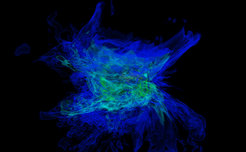Binary neutron stars: inspiral and merger
When binary neutron stars inspiral and finally merge they emit gravitational waves.
PSR J0737-3039: inspiral and merger
Ejected matter
The short clip shows the merger of two neutron stars with 1.34 and 1.25 solar masses. The blue material is the matter which becomes unbound and leaves the system. The most likely scenario is that ejected matter from neutron star mergers is the main source of heavy elements in the universe.
Inspiral and merger of a neutron star binary
The image shows the material which is ejected during the merger of the two neutron stars.

Density, entropy, gravitational wave, and ejected material
The animation is a combination of different movies and shows inspiral and merger of two neutron stars with 1.34 and 1.25 solar masses. The different panels show the density (upper left), the entropy (upper right), the gravitational wave (lower left) and the ejected material (lower right).
In addition to the visualization we add sound. The sound track is generated in a way that we create a sinusoidal sound with the same frequency as the gravitational wave signal and with an amplitude varying proportional to the gravitational wave’s amplitude.
Inspiral and merger of a neutron star binary
Note: Publication of the images requires proper credits and written permission. Please contact the AEI press office in advance of publication or for higher-resolution versions.
Credit:
T. Dietrich (Friedrich-Schiller-University Jena and Max Planck Institute for Gravitational Physics); BAM collaboration
The BAM collaboration is an international collaboration between the Florida Atlantic University, Friedrich-Schiller-University Jena, Istituto Nazionale di Fisica Nucleare, Max Planck Institute for Gravitational Physics, Università di Parma, Universidade Federal do ABC.














